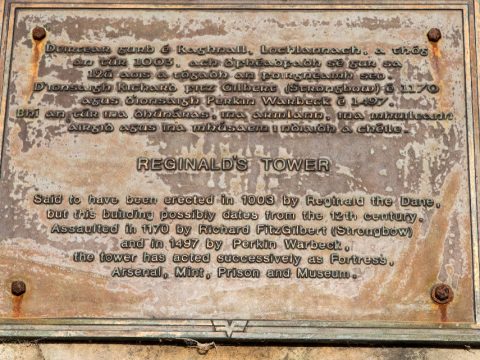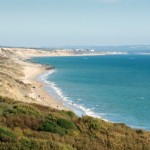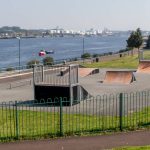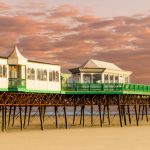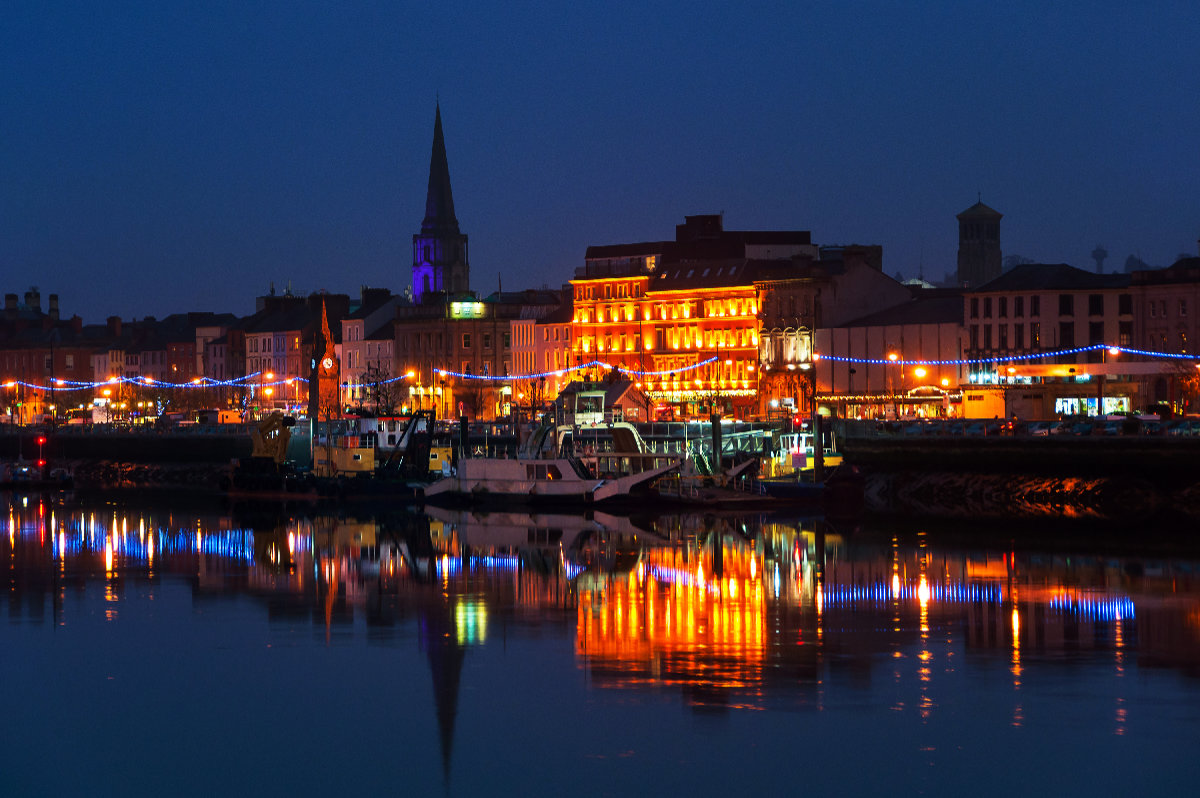
The Five Minute Tour of Waterford
Got five minutes free? Then come explore Waterford a gem of a city with us that sprawls over Ireland’s south-eastern coast.
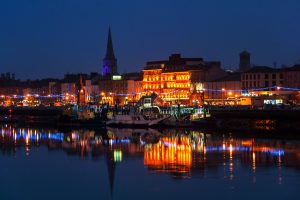
Image: Madrugada Verde/Shutterstock.com
Somewhere in the Province of Munster and towards the south and east of Ireland, you will come across the strikingly pretty city of Waterford. It features some of the most gorgeous, most romantic waterfront settings in all of Ireland. Some fifty thousand people call this special place home, and we want to know just what it is that makes it quite so spectacular… asides from a legendary history in crystal and glass making, of course.
Let’s start with the good old days and work our way forward from there. If you have Five Minutes Spare why not join us for the story…
Waterford – the Beginning
People are still arguing over exactly when Waterford was founded. The settlement was first established by the Vikings; but whether in 853 or 914 is up for debate. The Norsemen built earthen city walls and the first fort where Reginald Tower would later be built. The Vikings were hounded out of Ireland at one point only to return again a few years later. It is likely this that causes confusion. Until 917, Waterford was ruled by Jarl Ottar, then afterwards by Ragnall UA imar. Ottar died in battle against the hated scots, only to be succeeded by his closest enemy. It was then ruled by a succession of leaders of varying fame.
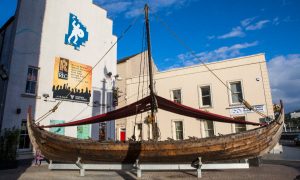
There is a replica Viking Longboat by the quay near Reginald’s Tower symbolising Waterfords Viking links.
Image:chrisdorney/Shutterstock.com
The most famous king of Waterford was Ivar, who also ruled Dublin for a year until he was expelled at the hands of the next guy. If the Game of Thrones was real, it was set in Ireland circa 1000 AD.
A hundred years later they were rebuilding Reginald’s Tower in stone and starting to repurpose it as a mint. In 1202 it became a city when King John granted them a royal charter, something that finally put Waterford firmly on the map. The charter would have allowed them to clean and pave the city streets, as well as perhaps running a weekly market.
1167 saw the deposed King of Leinster make a desperate bid to assault the walls of Waterford. They took the city after a siege, and after employing the allegiance of the invading Norman army led by Richard de Clare. By then, it was already an important port, large in size and famous for producing coin. Interestingly, Waterford was declared a Royal city alongside – but before – Dublin was, after the Norman invasion.
The 13th century also saw the arrival of black-robed Dominican friars and grey-robed Franciscans. They would preach the good word far and wide, particularly targeting cities that had a lot of travellers.
For the next few hundred years, Waterford was a centre of trade and wealth. It was known to be the second city only to Dublin during this time. Indeed, it is often considered it’s peak. Nowadays it is the fifth most populous city in Ireland, back then it was probably second. Waterford Harbour became a whole area, rather than just a harbour, as the port grew in significance.
The last occasion of note in the earlier years of Waterford is in 1492, when a ‘pretender’ to the throne came to Ireland to garner support to overthrow King Henry VII. Waterford stayed loyal to the king in spite of most of Ireland turning coats. The rebels laid siege to the city for 12 days then gave up and the king gave Waterford an important motto, in return. ‘Waterford the unconquered city’ was its new title, even though it had been taken in the past by the Vikings. So it does make sense, in a roundabout kind of way.
Let’s pause a minute and break up all this history with something a little different.
Famous People from Waterford City and Harbour
Since this place has been on the go since the Vikings first decided they needed forts to raid from, there has been ample opportunity for famous people to have been born in Waterford. Here are some of our favourites, as chosen by the most well known to Five Minutes Spare’s Millennial audience… Sorry about that.
- There has been a whole football team of famous hurlers to have come out of Waterford. Some of the biggest names include Johnny O’Connor, John Keane, Philly Grimes and Mick Flannelly.
- Physicist Robert Boyle, as well as Ernest Walton, Nobel Laureate in Physics in the fifties.
- Singer and songwriter Gilbert O’ Sullivan didn’t get an Irish second name by being from elsewhere.
- Valentine Greatrakes was from Waterford. You have never heard him, but he was a faith healer who toured Ireland in 17th In 1666 he laid hands on a man from England to no effect and was banned from laying hands on anyone else in Ireland by the Bishopric. He probably did though. Just saying.
- Thomas Sautelle Roberts the Landscape Artist, best known to art historians, was a Waterford man.
What we see when we look at Waterford isn’t a range of currently famous people. They have a list of sports personalities and politicians the length of your arm – but they also have historical celebrities you would never have dreamed of until you read the list. Let’s get back to that history, it’s a safer place to be than the present.
16th and 17th Century Waterford
Fishermen and their families flocked to town throughout these years until a busy fish trade took place. The Protestant Reformation seemingly passed the city by, except, of course, for the closing down of the friaries throughout the land. However, Waterford dug its heels in and remained a catholic city. It must have experienced a huge surge in population, if only because of the volume of displaced Catholics looking for a home at the time. They became part of the Confederation of Kilkenny, a band of settlements that maintained an independent Catholic Government. This was put to a stop by Oliver Cromwell and his cronies during the English Civil War. Waterford returned to English rule in 1650 – but only after a long siege and resisting Cromwell himself for a full year.
Waterford Gets a Hospital
In 1546 the Holy Ghost Hospital was put together to care for the elderly. There weren’t too many places like that back then, even though the care home nowadays is a common occurrence. The people recycled the friary space to make the home. Later, the Huguenots arrived after being expelled from France. They settled in many harbour towns in the British Isles. Waterford was one of these ports and it benefitted from their presence. The Huguenots were skilled weavers, refugees with a trade. They taught the locals their business and soon made flax cloth, sails for boats, and all types of linens. They were housed in the old Franciscan Friary, so now both of the old buildings were repurposed. This building was used right up until 1819.
In 1588 the area was deemed unprotected and one of the many kings built Duncannon Fort. Legend has it that the fort here was first erected in the 3rd century, which would actually coincide with the early settlement of Waterford. As one of the oldest cities in Ireland, Waterford harbour has always been a little vulnerable to attack. The current version of the fort was first built in 1588.
In 1690 the Williamite War overcame Ireland and the Jacobite’s fought… pretty much everyone else and lost. It was at Waterford that they were forced to surrender. They had the Battle of the Boyne, didn’t win, and were brought to the city to formally give up. Things were quiet for a year or two, and then the city started to expand.
The 1700s & 1800s – Rise and Decline
The 17oos was a busy time in the City with the population growing and trade flourishing. Some key events that occurred in this century included:
1739 St Olaf’s Church is built
1764 St Patricks Church is built
1773 Christ Church is built
1785 An infirmary opens in Waterford
1788 City Hall is built
1793 The Cathedral of the Holy Trinity is built
1794 A wooden bridge is built over the River Suir “Old Timber Toes”
1795 The Chamber of Commerce Building is erected
Also in the late 17th Century French Protestants fleeing persecution find a haven in Waterford.
A barracks and military camp were added in the 18th century and several religious establishments were erected. As the town prospered and grew, notable people popped up. The famous architect John Roberts designed several buildings, including the City Hall, Chamber of Commerce Building and possibly most famously the Catholic Cathedral of the Most Holy Trinity. Constructed between 1791 and 1796, it remains the oldest Roman Catholic cathedral in either Britain or Ireland given that all the ancient Catholic cathedrals were claimed by the Church of Ireland during the reformation. There is a sad story attached to this in that John Roberts who was in his eighties at the time died from a chill he caught after falling asleep in the Cathedral early one morning during its construction. So sadly he never really go to see his masterpiece in all its glory.
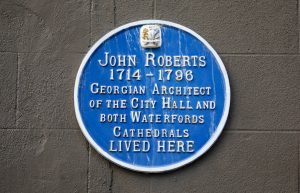
Waterford Crystal Is Born
This period of prosperity continued with the addition of an infirmary, a city hall, and finally a bridge across the River Suir. In 1783 two brothers founded a glass factory and altered production in the city forevermore. They helped nudge the city of Waterford into the Industrial Revolution that a fair few areas of Ireland were too busy fighting in to observe. The glass factory went on to make Waterford Crystal, now world-famous for its clarity and quallity.
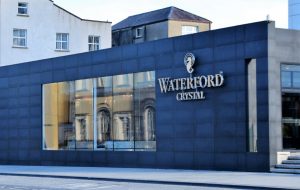
Image: Vintagepix:Shutterstock.com
By 1813 there was over 25,000 inhabitants and this grew steadily over the following two decades, peaking at over 28,000. The city prospered exported preserved meats, butter, and fresh produce including fish, beef and pork. Waterford did a brisk trade with their brothers in Newfoundland and to this day you can find a large section of the population there that has Waterford roots. A workhouse was built in 1841 to keep the poor folk occupied and fed especially when the Potatoe Famine (Gorta Mór) hit, tragically decimating not only the locals but the population of the whole country. The city was already suffering somewhat from the Glass Tax which had been introduced in 1825 – hitting the towns biggest manufacturing industry hard and the local population tumbled as thousands starved and more emigrated. The railway network did reach Waterford in 1853 bringing some relief, however, even with this new influx of food by 1861 the population was down by over 20%. It would not recover its earlier numbers until after WWII.
Although not widely taught in history classes this was a tragedy which should never be forgotten especially given the modern-day pressures on food supplies. If you are in Waterford and you want to learn more about it then the Waterford Country Museum has a great exhibit covering this sill relatively recent tragedy.
Modern Times – Back On The Up
By 1901 things were looking better for the city and the population was recorded at 26,769 – quite a way below that of the early 1800s but still huge for a city in Ireland at that time. The 18th Century “Old Timber Toes” bridge was replaced in 1913 with a safer and more substantial stone version and things were rosy until WWI hit. Many of the cities young men left for the battlefields of Europe and never returned and if that was not bad enough the Irish Civil War followed soon after. In 1922 the city was laid under siege for the fourth time in a Millenia this time by government forces and a four-day artillery bombardment ensued to quell the residents’ resistance.
The ensuing years to the end of WWII were not great for the City with little in the way of population growth and the economy was hit hard by the 1930s Anglo-Irish Trade War which lasted for most of the 1930s. Ireland remained neutral during WWII largely to avoid a second civil war hence the city didn’t suffer any damage. This was not a vintage time for Ireland as a whole so the less said about it the better.
Anyway, 1947 saw the revival of Waterford Glass which grew steadily over the next decade, before becoming the worlds best-known name in handcrafted crystal in the 1960s & 1970s. The return of the glassmaking factory helped tremendously and while many local industries died out, this one kept going and remains a significant contributor to the economy to this day. The addition of shopping centres and a Marina in town also added to the economy so that – in spite of so many recessions we lost count – the city is doing alright for itself.
As we know it today, Waterford produces fine things in a seaside resort town with a great retail background. They have a fantastic little corner of the earth with brilliant sea views and plenty of hope for an optimistic future. We like Waterford. The city gives us a little hope for the future, too.
Fun Facts About Waterford!
We researched what the best Waterford facts were so that you can arm yourself before you go. Don’t let those locals fool you – here are the things you should know about Waterford, in Ireland, before you go there:
- That famous architect we mentioned above? He built both the Catholic and the Protestant Cathedrals. This is the only place in the country where that happened!
- Reginald’s Tower is the oldest urban Medieval monument in Ireland, which is an impressive accomplishment in a country that is known for predating history…
- Irish people emigrated heavily through Waterford Harbour during the Great Famine.
- The first governor of New Zealand William Hobson was Waterford born and bred
- The literal translation of Waterford into Irish is ‘leg-shaped river’. Apparently, when you see it from the air you know why. The next logical question, then, is how the ancient Irish knew that it looked like a leg from the air?
- The Irish flag’s tricolour design was created by a Waterford man (Thomas Francis Meagher).
Now that we have dazzled you with an array of fine fun facts, let’s talk attractions. If you are spending your vacation at home this year or travelling to this ancient city of culture – then here’s what you need to know…
Attractions in Waterford
When you visit this area it is pretty special. The city is so filled with history and Irish culture that there are a ton of fun things to do in Waterford. We took our pick and now present the Five Minutes Spare favourites. Enjoy!
Historic Sights and Landmarks
When in the city, make sure you visit the old ‘French Church’. This is the former Franciscan Friary that was originally built in 1241. Later, it held the Huguenots when they fled persecution. There is a lot of history in this beautiful ruin. Make sure to seek it out.
Another thing to seek is the Fort at Duncannon. This small village forms a jutting headland that made it the perfect place to build a medieval defensive fort. It sits just to the north of Waterford Harbour and has one of the most beautiful beaches in the area, which is never too packed because it is a fishing village. They rely heavily on tourism to survive, so make sure you buy some fish and chips while you are there.
One of the most important economic contributors to Waterford over the years has been the glassmakers. Waterford Crystal is world famous – and is still being made today, after nearly three hundred years. Best of all, you can tour the factory and learn all about it. This is a great activity for a school outing or an educational trip.
Museums and Galleries
When in town, take a moment to browse around the Waterford and County Museum. They have several exhibits detailing the lives of the people of the city down through the ages. They have more in-depth details about the many sieges of Waterford than we could ever recount. Another interesting museum to visit is Reginald’s Tower. This repurposed building was first erected all the way back in the 10th century and is well worth the tour to find out how the Vikings lived. It is also part of a trio of medieval museums that let you experience the full thrill of the dark ages. They call it the Waterford Treasures.
They have a bit of an art festival here which is always worth your while. 2020’s will hope to start on July 13th with a variety of street artists. Waterford Walls is the name of the festival and we have our fingers crossed that it gets the go-ahead after coronavirus.
Shopping and Retail
The two biggest centres in town are the Waterford Shopping Centre and the City Square Shopping Centre. City Square is more central and right on the river. It also has access to the retail district right there on the doorstep. Waterford has free parking though, so the choice is yours.
Historic markets are a little thin on the ground here since everything is technically historic. That being said, make sure you visit the Apple Market where produce has always been given out in the past.
Sports Teams
Waterford Football Club is the city’s top team dating back to 1930, and they at the time of writing (2019-20 season) they play at the highest level, The League of Ireland Premier Division. Their home stadium is the Waterford Regional Sports Centre and given it has a capacity of 5,500 you should be able to pay at the gate unless its a big derby game against Cork. Even then you probably only need to book a ticket in advance if you want a seat.
The standard of play is quite good, but don’t expect to see international stars as like most teams in Ireland they are semi-professional. They have not been a force of late – only regaining their Premier League status in 2017, however, historically they have, winning the title six times in the 1960s and early 1970s. They have played in Europe a few times, most notably reaching the European Cup 2nd Round in 1970-1 where they lost to Glasgow Celtic. If you are visiting and are a football fan definitely consider taking in a game if they are playing or have a look at the stadium. You can check on Waterford FC here to book before you go.
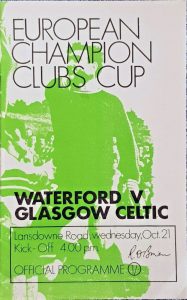
One of Waterford’s finest footballing nights – sadly not played in the city though.
If the oval ball is more your game then you are catered for too thanks to Waterford City RFC who are one of Ireland’s oldest Rugby clubs having been founded on Saturday, 8th July 1893 (hows that for precision!). They have various teams including Women’s & Juniors but the main Men’s squad (in 2020) compete in Division 2 of the Munster Junior League.
Gaelic Football is also popular in Waterford and the County even has its own Competition the Waterford Senior Hurling Championship which dates back to to 1897. Mount Sion have traditionally been the powerhouse team having won the title on 35 occasions, however, of late they have been playing second fiddle to Ballygunner who have won it six seasons running from 2014-2019. If you have never seen a game before you might be a bit puzzled by the scoring and of course some of the tackling is not for the faint-hearted. Still its an experience not to be missed.
Outdoor Attractions
The Waterford Greenway is actually voted number one attraction on Trip Advisor. This area covers a few attractions on the green belt area, including a beautiful old bridge, the King of the Vikings tour, and the Mount Congreve Gardens. There are several biking tours in the area, as if it were the south of France!
Alternatively, head our on Comeragh Drive. This is a perfect hiking trail for those that enjoy the vast freedom of the outdoors. There are plenty of rocky crags and hidden streams to be explored. If you are looking for somewhere to picnic on a sunny summer afternoon, then the People’s Park has everything you need.
If you like a round of golf then you are in luck as Waterford has a really nice course which dates back to 1912 and given it was designed by Willie Park junior twice Open Champion, and James Braid, five times Open Champion you can imagine this parkland course it is quite challenging. Still, it’s worth it even if you get a round of bogeys as it has quite magnificent views both of the city & the Slievenamon and the Comeragh Mountains.
Other Notable Attractions
These are only the tip of the iceberg in terms of Waterford Attractions. Naturally, a city this old has evolved a few interesting places that you will want to check out – but that we didn’t have time to cover in full. If you are on holiday to Waterford, make sure you have a look at the following things to do:
- Seek out the Bishop’s Palace. This is part of the Treasures of Waterford trio of museums and will be covered if you get the ticket for the others.
- Visit your relevant Cathedral, or both if you are studying architecture. The Cathedral of the Most Holy Trinity and Christ Church Cathedral still stand and are a testament to the maker’s skill.
- Stop in at the Theatre Royal – remember you are in a royal city! – and catch a show.
- Visit Waterford Nature Park. It is beautiful and always busy on sunny days.
You will find something to do here, no matter your tastes. If all else fails, go to the harbour and dream about the yachts. It’s always nice to be beside the sea.
How to get there?
We have given you all the information we managed to dig up about Waterford – except how you get to the place.
By Road
Head south out of Dublin and follow the M11 (N11) all the way to the N30, cut across to the N25 and you are there. There are shorter routes but this way you will see the beauty of the coast. Here’s the motorway map for more info.
By Rail
Waterford Railway Station is pretty central and is run by Eiretrains.
By Air
Waterford Airport is obviously closest to the city but you also have Cork and others within driving distance.
By Sea
Aim for the Port of Waterford, south and west of Dublin.
Got Five Minutes?
Did we manage to pique your interest with our little report about Waterford? We sure hope so. If you can’t get enough of our witty one liners and sad, sad puns, then head over to the Five Minutes Spare Travel pages and read through some more itineraries. You might never get there, but you can always read about your dream destination and have a laugh in the process… right?
